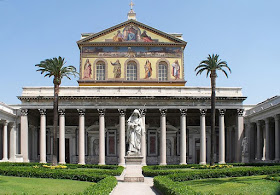Visita Iglesia (Spanish for "Church Visit") is a Holy Week devotion among Filipino Roman Catholics of visiting seven or fourteen churches in order to pray and meditate on the Passion of Jesus Christ. It traditionally commences in the late afternoon or early evening of Holy Thursday after the Mass of the Last Supper when the Blessed Sacrament is already reserved at the Altar of Repose for adoration inside the Church until midnight when it is concluded without solemnity since liturgically, the day of the Lord's Passion has already begun[1].
 |
| Basilica of St. John Lateran |
 |
| Basilica of St. Peter |
 |
| Basilica of St. Mary Major |
 |
| Basilica of St. Paul outside the Walls |
 |
| Basilica of the Holy Cross in Jerusalem |
 |
| Basilica of St. Lawrence outside the Walls |
 |
| Santuario della Madonna del Divino Amore |
This practice which became a tradition was evidently influenced by the Spaniards who colonized the Philippines for nearly four centuries and introduced the Roman Catholic faith. It was thought that the Augustinian friars, the pioneer missionaries of the Philippines who arrived in 1565, propagated this devotion. They were inspired by their fellow Augustinian St. Philip Neri (1515-1595) who established a confraternity in 1548 to minister the needs of thousands of poor pilgrims who flock to Rome, especially during the jubilee years [2]; and established in 1559 the visitation of the seven traditional pilgrim churches in Rome as a form of penance. [3] The circuit of seven Churches is traditionally composed of St. John Lateran, St. Peter, St. Mary Major, St. Paul outside the Walls, St. Lawrence outside the Walls, Holy Cross in Jerusalem, and St. Sebastian outside the Walls. Pope John Paul II replaced St. Sebastian with the Sanctuary of the Madonna of Divine Love for the jubilee year of 2000.
 |
| 'St. Philip Neri' by Sebastiano Conca |
The Visita Iglesia is based on the Biblical accounts of the first sorrowful mystery, the Agony in the Garden. After the Last Supper when Jesus Christ instituted the Sacraments of the Holy Eucharist and Holy Order, Jesus went to a place called Gethsemane to pray where He felt sorrow and distress. He asked His apostles Peter, James and John to remain and keep vigil with Him but they fell asleep thrice [4]. Thereafter, Judas Iscariot kissed Jesus as a sign of his betrayal which is properly the beginning of the Lord's passion. Likewise, in the practice of Visita Iglesia, Jesus is asking the faithful to remain, keep vigil and accompany Him in the sufferings that is taking place.
 |
| Judas kissed Jesus |
There is no prescribed prayer for the Visita Iglesia since it is not essentially a part of the liturgy but a popular piety. Some would accompany their visit with their personal prayers and the meditation of the mysteries of the Holy Rosary. Others would pray the Via Crucis (Stations of the Cross), a tradition taught by the Franciscan, two stations in one Church. Still, others have expanded the number of churches into fourteen with one station in each church. It is also recommended to include the poor and suffering fellowmen in our intentions.
There is no prescribed number of Churches to be visited either. Traditionally, it is seven in number which signifies completeness and perfection while a contemporary and more penitential fourteen churches can also be practiced. Nevertheless, the number of churches does not matter because what’s important is that the faithful prays intently and fervently from the heart.
This practice is commendable because it makes the vigil of the reserved Blessed Sacrament inviting and it deepens the prayer and contemplation on the passion of Christ. It is not only a way for family members to bond but also to cultivate in each member the spirit of prayer and penance.
The Reposition of the Blessed Sacrament on Holy Thursday is an austere solemn conservation of the Body of Christ for the community of the faithful which takes part in the liturgy of Good Friday and for the viaticum of the infirmed [5]. It is an invitation to silent and prolonged adoration of the wondrous sacrament instituted by Jesus on this day. [6]
[1] cf. Congregation for Divine Worship, Lettera circolare sulla preparazione e celebrazione delle feste pasquali, 56.
[3] Cervantes Encyclopaedia, p. 670.
[5] cf. Congregation for Divine Worship, Lettera circolare sulla preparazione e celebrazione delle feste pasquali, 55; Sacred Congregation of Rites, Instruction on Eucharistic cult Eucharisticum mysterium, 49, in AAS 59 (1967) 566-567.
[6] Congregation for Divine Worship and the Discipline of the Sacraments, Directory on Popular Piety and the Liturgy, no. 141

No comments:
Post a Comment
God bless you!